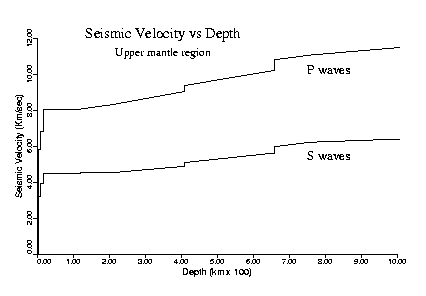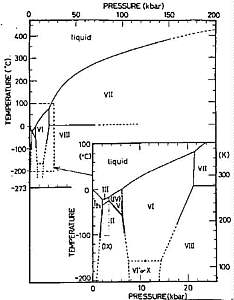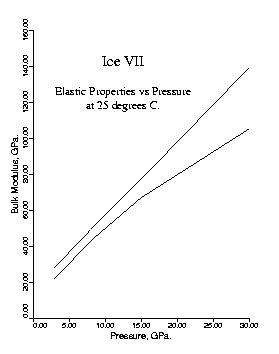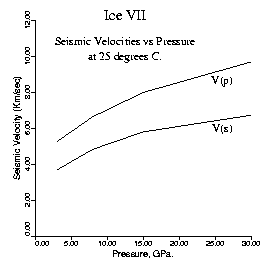Subcrustal Ice Earth Model
Contents
Return to The Creation
Concept
What's Down Inside?
Could the earth contain a subcrustal ice layer? Jupiter's largest
satellites, Ganymede,
(diameter 5,262 km, density 1.94 gm/cm3), and Callisto,
(diameter 4,800 km, density 1.86 gm/cm3) have water/ice mantles
and rocky cores. Ganymede's crust probably consists of a thick layer of
water ice.
The earth is unique in the solar system because of the presence of liquid
water at the surface, and its high density core. The earth's atmosphere,
also, is uniquely constituted for sustaining life. But evidence for ice
and water elsewhere naturally leads to the question, why couldn't the earth's
interior also contain an ice layer? The Subcrustal Ice Earth Model
(SIEM) is being developed to investigate this possibility.
According to the conventional theory of plate tectonics, water and other
materials from the earth's surface are recycled to the deep interior by
hypothetical processes of subduction and convection. The driving force
for the postuated movements of the plates is mantle convection, a process
invoked by Arthur Holmes as a mechanism for continental drift.
The
Inner Workings of the Earth by Michael Wysession, from American
Scientist, March-April 1995 presents a discussion of current thinking
about mechanisms for recycling water and other materials from the earth's
surface to the deep interior. According to the theory, some of this water
returned to the interior by convection driven processes becomes ejected
in volcanic eruptions.
The convection hypothesis comes under critical scrutiny in: Is
mantle convection no more than a storm in Arthur Holmes' porridge bowl?
This author of this article [presumably Dr. Ken Duckworth, professor of
geophysics at the University of Calgary], uses the pseudonym A.H.E.Retic.
He tilts against "a concept so powerful that even today it has become a
Mantra to be chanted by all should they ever hope to get a grant to study
any aspect of the crustal behaviour of the earth". The article identifies
several fatal flaws in the standard dogma of mantle convection, and develops
some helpful Retic's Rules.
Could the concept of recyling of water from the earth's hydrosphere
back into the depths of earth, (needed for the conventional view of an
ancient earth, billions of years old) be wrong? Thermodynamics suggests
bodies that are heating up degass. The high concentration of radioactive
isotopes in rocks could mean the earth is heating up. See The
Heat of the Earth.
A 1995 paper by Lars Stixrude, Mineral
physics of the mantle from Reviews of Geophysics considers possible
mechanisms by which water and volatiles could exist deep in the earth's
interior, combined with other minerals. Stixrude notes that 1% by weight
water stored in the earth's mantle amounts to 30 hydrospheres.
If the water and volatiles in the earth's interior are primeval, the
earth could not be billions of years old!
The
New Alchemy by Robert M. Hazen reviews the history of high pressure
research.
Deep Waters
is a recent article from New Scientist about why abundant water exists
in the earth's mantle.
Earth's
Interior May Contain Oceans Of Water, Geologist Says
COOKBOOK COSMOLOGY
In these articles, Neil B. Christianson proposes an earth model featuring a cold hydrogen core and high pressure ices in the mantle. (Apparently the density distribution postulated does not lead to the correct moment of inertia.)
Earth Density inter-active model - Try to figure out the density distribution in the earth, with the correct total mass and moment of inertia.
AK135
Travel Time Tables: A seismic model of the earth's interior.

This chart of seismic velocities shows clear discontinuities exist in the
earth's upper mantle near about the 400 km and the 660 km levels.
Deep-focus earthquakes are clusted near the discontinuity at 660 km. Some
scientists consider these deep earthquakes to be anomalous; conventional
earth models assume very high temperatures exsit at those depths, where
earthquakes would be less likely to occur; see What
is exploding 400 miles beneath our feet?
Information about gravity and magnetic anomalies and their implications
for the earth's interior is discussed at: Complexities
of the inner earth.
Return to Contents
Ice Polymorphs
Phase Diagrams
The diagram at right is a phase diagram for water to 200 kbar and 450 degrees
C. This is figure 1, p. 2455 from Mishima, O and S. Endo, 1980. Phase relations
of ice under pressure. J. Chemical Physics 73(5) 2454-2456.
H2O Phase
Diagram for low pressures. |
 |
 |
Elastic Properties of Ice VII
The graph at left shows the variation of the elastic moduli of Ice
VII with pressure, calculated from experimental data in: Polian, A. and
M. Grimsditch. Brillouin scattering from H2O: Liquid, ice VI,
and ice VII. Physical Review B 27(10): 6409-6412, May 1983.
The upper line shows the Bulk Modulus; the lower line is the Shear Modulus. |
Seismic Velocities of Ice VII
The graph at right shows the variation of seismic velocities with pressure
in Ice VII, calculated using the data in the previous reference together
with more recent published density measurements. |
 |
The following links provide information on some of the physical properties
of water, phase transformations, and high pressure ices:
Bibliography - High
Pressure Research
Return to Contents
Oceanic Hydrothermal Vents
High flow rates of emissions from hydrothermal vents on the ocean floor
provide possible evidence for melting of a subcrustal ice layer in the
upper mantle. Conventional explanations invoke convection of seawater in
the vicinity of the vents as the driving mechanism. Flow rates as high
as 5 m/sec have been observed at some black smokers. Pressure in the conduit
through the ocean crust must decrease in the direction of flow, and frictional
resistance is greater for high flow rates. The convection mechanism, based
on the density difference between the heated water and cold sea water,
could work only if some unique system of cracks allowed sufficiently large
volumes of sea water to flow down to the heat source with a minimum of
frictional resistance.
In the convection hypothesis, enormous amounts of heat must also be
continuously supplied for the duration of the vents to heat the circulating
sea water.
For an introduction to submarine hydrothermal vents, see Deep
Sea Hydrothermal Vents by Melanie Summit and the University of Washington
School of Oceanography Exploraquarium.
A discussion of the convection mechanism can be found in Hydrothermal
processes at mid-ocean ridges by Susan E. Humphris.
Photos and videos of black smokers can be found on the following sites:
The episodic nature of venting processes does not support the convection
hypothesis, as the venting of large volumes of pressurized water in a short
time from reservoirs in the oceanic crust seems inconsistent with convection.
The discovery of "megaplumes" of enormous volumes (up to 130 km3)
of hydrothermal fluid over the Juan de Fuca Ridge in the northwest Pacific
Ocean in 1986 and 1987 is discussed in Episodic
venting of hydrothermal fluids From the Juan de Fuca Ridge by Edward
T. Baker et al.
The rocks of the ocean crust and the earth's interior and hydrothermal
emissions are enriched in the primordial helium isotope, 3He.
The higher 3He/4He ratio of vent emissions distinguishes
them from sea water.
 The plume of 3He enriched seawater caused by hydrothermal venting
or volcanic activity at the East Pacific Rise was investigated by the Helium
and Tritium in the World Ocean Circulation Experiment (WOCE) Pacific Program.
The plume of 3He enriched seawater caused by hydrothermal venting
or volcanic activity at the East Pacific Rise was investigated by the Helium
and Tritium in the World Ocean Circulation Experiment (WOCE) Pacific Program.
-
For more related information see:
-
Changes
in submarine hydrothermal 3He/heat ratios
-
Ongoing Volcanic
Seismicity on the Gorda Ridge
Return to Contents
A text file containing several postings to the newsgroup talk.origins on
questions related to SIEM. [About 52 kbytes]
Waters Under the
Earth - What ancient scriptures say about the subterranean waters.
Return to Contents
Also of interest
Two Really
Deep Oceans from Science Frontiers, by William R. Corliss.
The
Biosphere Below by Daniel Grossman and Seth Shulman discusses the living
microorganisms that thrive kilometers deep in rocks, some called heterotrophs,
which feed on decaying plant or other organic material buried in sediments;
others called lithotrophs, perhaps the most common, which live off
geothermal energy, eating hydrogen present in deep rock formations.
New
evidence for long-distance fluid migration within the earth's crust
by M. Person and L. Baumgartner cites evidence for fluid movements of hundreds
of km.
Return to Contents
Submarine Methane Hydrates
Deposits of methane hydrate occur in sediments of the ocean floor, and
in Arctic permafrost areas, including Siberia. Conventional theory, which
assumes the earth was once a hot, molten body, says most of the methane
in submarine sediments came from bacteria, but this is still uncertain.
It is interesting to note that properties of clathrate hydrates are studied
as possible constituents of the interiors of other bodies in the solar
system. The following links provide information about submarine methane
hydrates.
Return to Contents
On dissent
New theories, scorn and
derision - by William Beaty.
Return to Contents

© Copyright 1996 by Douglas E. Cox
Return to The
Creation Concept
All Rights Reserved.





